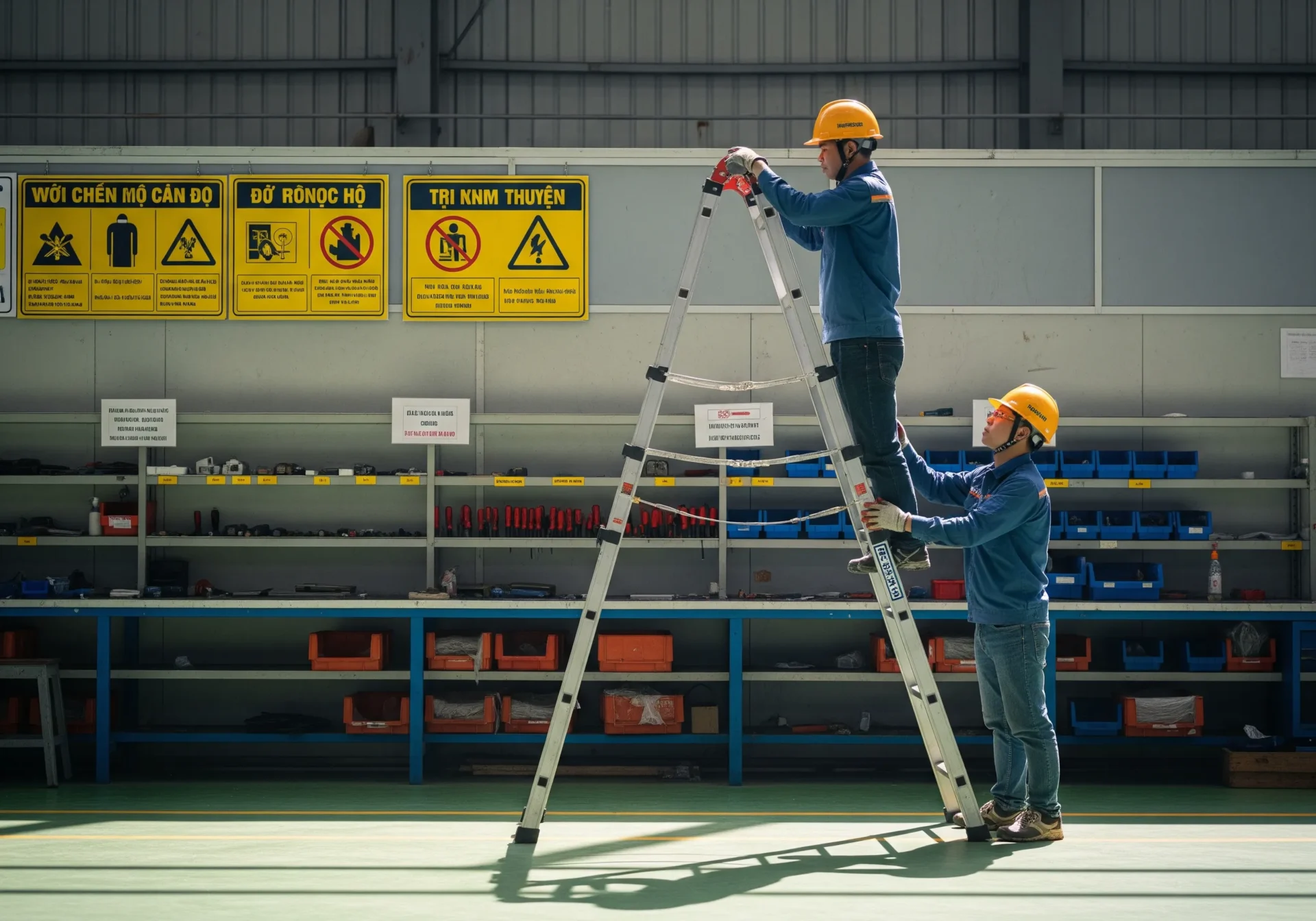Introduction
Ladders and stepladders are used daily in various worksites in Vietnam, including manufacturing, construction, and logistics. However, precisely because they are so common, a moment of carelessness or incorrect use can lead to unexpected accidents. This article will use near-miss case studies that frequently occur at worksites as a starting point to explain why such accidents happen, their background, and their trends. Furthermore, based on statistical data from the Ministry of Health, Labour and Welfare and the National Institute of Occupational Safety and Health, Japan (JNIOSH), we will present the number of incidents and major injury sites while suggesting concrete preventive measures. The objective is for readers to gain hints for safety management that they can immediately implement at their own worksites.
Source: Hasegawa Members Club
Challenges and Background
Market Data
According to analysis by the National Institute of Occupational Safety and Health, Japan (JNIOSH), there are approximately one thousand industrial accidents caused by stepladders annually, with over eighty percent of them being falls or tumbles. Fractures, in particular, account for about two-thirds of all injuries, with injuries to the lower and upper limbs occurring in over half of the cases. Moreover, the number of fatalities from falls from “ladders, etc.” has remained at a high level of around thirty people each year for the past several years. There are differences in usage conditions and durability between commercial and household ladders, and using a household ladder in a professional environment increases risks due to age-related deterioration and insufficient structural strength.
Source: National Institute of Occupational Safety and Health, Japan (JNIOSH)
Risk Presentation
Typical examples of fall and tumble accidents that tend to occur at worksites include straddling the top plate, working on the top plate, slipping on wet or deteriorated anti-slip treads, and ascending or descending while carrying loads. Low stepladders, in particular, can lead to a lack of safety checks due to overconfidence, often resulting in serious injuries like fractures. Furthermore, failure to perform proper storage and inspection allows age-related deterioration, such as damaged rungs and loose components, to progress, increasing the risk of malfunctions.
Source: Ministry of Health, Labour and Welfare, Anzen Project Site
Product and Service Introduction
Features
Hasegawa products are based on a design philosophy that combines both safety and durability. The top plate is shaped and sized to enhance stability underfoot, and the treads are treated with an anti-slip finish, creating a structure that resists slipping even in wet environments or dusty worksites. Furthermore, by using lightweight yet highly durable materials, we reduce the burden of carrying and setting up the equipment while achieving a long service life. We also establish clear differences in load capacity and materials between household and commercial models to offer the optimal model for each application. A wide range of safety accessories, such as stepladders with handrails, portable work platforms, and safety blocks, are also available, allowing for customization to match the worksite environment and risks.
Source: Hasegawa Kogyo Co., Ltd. Product Information
Case Studies (Before → Action → After)
In a manufacturing setting, the conventional practice of straddling the top plate was eliminated and replaced with a safe work platform, significantly reducing the risk of falls. In a logistics warehouse, aged aluminum stepladders were replaced with commercial-grade FRP stepladders, enhancing durability and stability. At a construction site, the use of helmets and safety harnesses was mandated even when using low stepladders, establishing a system to prevent serious head injuries even from minor falls. All of these are successful cases where safety was improved while maintaining work efficiency.
Source: Hasegawa Members Club
Hasegawa’s Reliability
Quality Control and Certifications
Hasegawa is committed to manufacturing products that comply with international and domestic standards such as ISO certification and TCVN/JIS standards. All products undergo rigorous quality checks, including load-bearing tests and dimensional accuracy inspections, before being shipped to the market. We also focus on continuous product improvement by incorporating feedback from worksites, striving to enhance both user safety and work efficiency simultaneously.
Source: Hasegawa Kogyo Co., Ltd. Company Information
Customization and Support System
We flexibly respond to custom design requests for ladders and work platforms to suit diverse work environments and applications. For example, we have numerous customization case studies that solve worksite challenges, such as stepladders with safety fences for high-place work or slim designs for narrow spaces. Furthermore, we continue to promote safety awareness through safety training sessions and on-site product diagnostics. For members, we provide work manuals and video content, creating an environment where they can learn the correct usage and inspection methods at any time.
Source: Hasegawa Members Club
Data Box
| Indicator | Figure | Source |
| Number of accidents caused by stepladders | 992 cases (86% of which are falls/tumbles) | National Institute of Occupational Safety and Health, Japan (JNIOSH) |
| Percentage of fractures | Approx. 66% | National Institute of Occupational Safety and Health, Japan (JNIOSH) |
| Annual number of deaths (ladders, etc.) | Approx. 30 people | Report on Worker Deaths and Injuries (Ministry of Health, Labour and Welfare) |
| Percentage of lower + upper limb injuries | Over 50% | National Institute of Occupational Safety and Health, Japan (JNIOSH) |
| Rate of not wearing a helmet (fatal head injury accidents) | Approx. 84% | Accident Investigation Reports (Ministry of Health, Labour and Welfare) |
Conclusion
Many accidents involving ladders and stepladders can be prevented through proper product selection and correct usage. As shown by the statistics and case studies discussed in this article, carelessness and misuse can trigger serious disasters. The first step to protecting lives is to introduce safety measures tailored to the characteristics and work content of each site and to make regular product inspections and component replacements a habit. Furthermore, by utilizing the safety training, videos, and inspection checklists provided by Hasegawa, you can raise the overall safety awareness of your entire worksite. Safety is born from daily accumulation.
Source: Hasegawa Members Club

